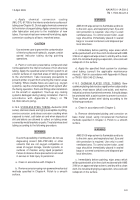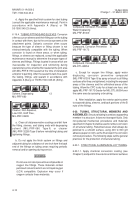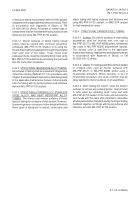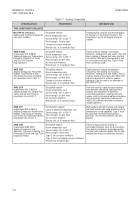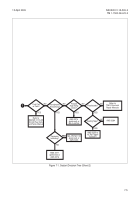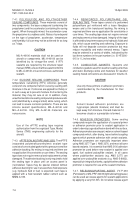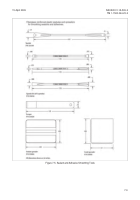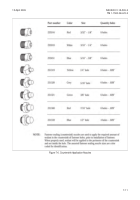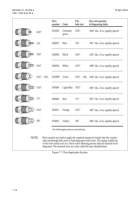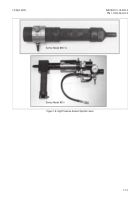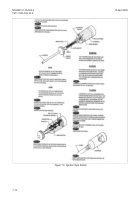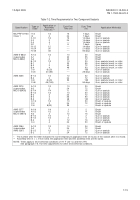TM-1-1500-344-23-2 - Page 122 of 240
7-6
NAVAIR 01-1A-509-2
TM 1-1500-344-23-2
15 April 2009
7-4.1. POLYSULFIDE AND POLYTHIOETHER
SEALING COMPOUNDS. These materials consist of
two components: the base compound (containing the
prepolymer) and the accelerator (containing the curing
agent). When thoroughly mixed, the accelerator cures
the prepolymer to a rubbery solid. Rates of cure depend
on the type of prepolymer, accelerator, temperature
and humidity; full cure may not be achieved for as long
as 7 days.
CAUTION
MIL-A-46106 materials shall not be used on
aircraft or components. MIL-A-46106 can be
identified by its vinegar-like smell. If RTV
sealants are required by the structural repair
manual (SRM), ensure that the sealant conforms
to MIL-A-46146, or is a noncorrosive, authorized
sealant.
7-4.2. SILICONE SEALING COMPOUNDS. Room
temperature vulcanizing (RTV) silicones generally
consist of one component which cures by reacting with
moisture in the air. If silicones are applied too thickly or
in such a way as to prevent moisture from entering the
material, they may not cure at all. In addition, many
unauthorized silicone sealing compounds produce acetic
acid (identified by a vinegar smell) while curing, which
can lead to severe corrosion problems. There are two
silicone sealant specifications, MIL-A-46146 and
MIL-A-46106. Only MIL-A-46146 materials are
noncorrosive.
NOTE
Use of the ePTFE sealing tape requires
authorization from the cognizant Type, Model,
Series (TMS) engineering authority for the
aircraft.
7-4.3. ePTFE SEALING TAPE (AMS 3255). The ePTFE
(expanded polytetrafluoroethylene) sealant tape
consists of an extruded gasket with a pressure sensitive
adhesive backing. No mixing is required and there are
no application life constraints or cure times. The sealing
tape does not require removal and replacement unless
damaged. The adhesive backing is only required to hold
the sealing tape in place until an access panel is
(re)installed. Tapes may be special ordered without
adhesive backing for use in areas where fluid exposure
(e.g. hydraulic fluid or fuel) is expected; such tape is
applied with a fluid resistant rubber cement such as
MMM-A-189.
7-4.4.
REINFORCED POLYURETHANE GEL
SEALING TAPE. These tapes consist of a preformed
polyurethane gel reinforced with a loose fiberglass
weave and a thin translucent backing. No mixing is
required and there are no application life constraints or
cure times. The sealing tape does not require removal
and replacement unless damaged. Integrity of the tape
is affected by long-term exposure to hydraulic fluids and
oils, which cause swelling and softening. Exposure to
fluids will not degrade corrosion protection but may
reduce reusability and make removal messy. Tapes
may be ordered in a variety of widths, indicated by the
last three numbers in the part number (i.e. IS-HT3000-
015 is 1
1
⁄
2
inches wide).
7-4.5.
CONDUCTIVE GASKETS. Sealants and
conductive gaskets used for weather sealing antennas
and static discharge wicks and materials for weather
sealing mated connectors are discussed in Volume III.
CAUTION
Use only those primers or adhesion promoters
recommended by the manufacturer for their
products.
NOTE
Solvent based adhesion promoters are
hygroscopic (absorb moisture) and must be
kept away from moisture. Discard material if it
becomes cloudy or a precipitate is formed.
7-4.6. ADHESION PROMOTERS. Some sealing
compounds require the application of a special primer
or adhesion promoter prior to sealant application in
order to develop a good adhesive bond with the surface.
Adhesion promoters are one part, water or solvent-based
compounds which, after drying, leave behind coupling
agents which promote adhesion with certain sealants.
Adhesion promoters are especially important when
using AMS 3277 Type I, AMS 3276, and most silicone
based sealants. It is essential that AMS 3100 adhesion
promoter be used before new sealant is applied over
aged, fuel soaked polysulfide sealant. In all cases
where polythioether sealants (e.g. AMS 3277) are
applied over polysulfide sealants (e.g. AMS-S-8802),
especially in integral fuel tanks, a polythioether adhesion
promoter is required for use at the sealant interface.
7-4.7. RELEASING/PARTING AGENT. VV-P-236
(Petrolatum) or MIL-PRF-32033 (light lubricating grease)
can be used as release agents for sealant applications
by applying a very thin film. Do not allow release agent
Back to Top


